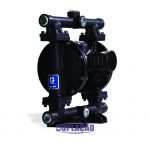As bombas pneumáticas de diafragma vêm sendo aplicadas cada vez mais frequentemente na indústria de mineração. Isso porque esse equipamento consegue entregar alto desempenho e segurança até mesmo nos ambientes mais severos.
Contudo, ainda que a maioria das indústrias já saiba o quanto essa bomba pode ser eficiente para o processamento de diversos materiais, ainda existem algumas dúvidas bastante recorrentes. Para te ajudar, separamos as perguntas mais comuns e as respondemos:
1. Como as bombas pneumáticas de diafragma são aplicadas na indústria de mineração?
In most cases, pneumatic diaphragm pumps are applied in ore processing and dewatering process within the mining industry. It can also be used for transferring chemicals and fluids, pumping explosives, removing water, and much more.
2. What type of pump is ideal for the mining industry?
It is very important to consider the flow rate and size of the pump that can be used in your operation. However, the most important factor to consider is the material your pump is made of. This choice will depend on the type of fluid that will be pumped to avoid deterioration of your product. For this, you can consult the compatibility table of your pump to avoid problems. There are some key factors to consider:
- abrasiveness;
- Temperature;
- Viscosity;
- Acidity level.
In addition, it is also important to determine if your pump will only be fixed in one location within your operation or if it will need to be moved. In the second case, it may be necessary to have a smaller pump that can be easily transported.
Air operated diaphragm pumps are portable and can be moved around without the need for an operator or maintenance technician to ensure safety and integrity.
3. Can pneumatic diaphragm pumps guarantee safety?
Because they are pneumatically operated, that is, air operated, these pumps can be applied in explosive and humid environments, which is the majority of cases in the mining industry.
4. Does this pump allow flow control?
The speed of the pneumatic diaphragm pump can be adapted to the needs of your industry. This means that a 3-inch pump can operate over a wide range of flow rates, from 15 gallons per minute to 280. This feature makes it one of the most versatile pumps on the market.
5. Can pneumatic pumps run dry?
One of the biggest advantages of pneumatic diaphragm pumps is their ability to run dry. Since these pumps use diaphragms and not mechanical seals, they are able to pump dry without risk of damaging its structure.
However, we need to mention that even though it has this characteristic, running it dry for long periods is not ideal, as it can cause wear on the internal parts in the same way that happens under ideal conditions.
6. Can you handle solids?
Pneumatic pumps are one of the best equipment for the mining industry as they can handle suspended solids of various viscosities.
7. Is it possible to extend the life of a pneumatic diaphragm pump?
In addition to being extremely versatile equipment with superior performance, there are some measures that help extend the life of your pump and save resources for your industry. Check out some articles on our website that deliver valuable tips to optimize the operation of your pump and make it deliver the performance you expect.
8. Are pneumatic diaphragm pumps too expensive?
In addition to delivering excellent performance, pneumatic diaphragm pumps have a low initial purchase cost when compared to other similar solutions on the market. There are some variables that can modify the price of your pump:
Makeup material;
Size;
Valve type.
9. Is the installation of the pneumatic diaphragm pump complex?
The installation of this pump is very simple, without the need for a certified operator. It also doesn't need special controls and your maintenance process it is quite simplified.










